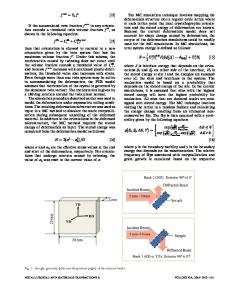Evolution of Microstructure and Texture During Deformation and Recrystallization of Heavily Rolled Cu-Cu Multilayer
- PDF / 2,859,522 Bytes
- 16 Pages / 593.972 x 792 pts Page_size
- 52 Downloads / 385 Views
ODUCTION
METALLIC multilayers are known to possess better mechanical properties compared with monolithic materials.[1–4] In addition to the dislocation pile up at the grain boundary, as occurring in conventional bulk polycrystalline materials for strengthening, multilayers possess an additional constraint for either confined layer slip,[5] or the dislocation movement across the interface. Hence, the increase in strength is contributed by grain size refinement as well as the interface spacing of the lamellae. The synthesis methods available for multilayers include thin film deposition techniques[6–10] and roll bonding processes.[11–15] The response of these types of multilayer composites to large strain plastic deformation has been studied by characterizing the evolution of hardness, texture, and microstructure.[7,9–13] However, most of these studies focused on dissimilar materials that demonstrate additional hardening behavior pertaining to modulus mismatch, lattice incoherence, and chemistry. Hence, the deformation characteristics and evolution of texture in such dissimilar multilayer K.S. SURESH, formerly Ph.D. Student with Department of Materials Engineering, Indian Institute of Science, Bangalore 560012, India, is now Post Doctoral Researcher with High Temperature Materials Unit, National Institute for Materials Science, Tsukuba, Ibaraki 3050047, Japan. A.D. ROLLETT, Professor, is with the Department of Materials Science and Engineering, Carnegie Mellon University, 5000 Forbes Avenue, Pittsburgh, PA 15213. SATYAM SUWAS, Associate Professor, is with the Department of Materials Engineering, Indian Institute of Science. Contact e-mail: satyamsuwas@ materials.iisc.ernet.in Manuscript submitted August 27, 2012. METALLURGICAL AND MATERIALS TRANSACTIONS A
composites is quite complex. Dislocation transfer across an interface (grain boundary) in a monolithic multilayer is much easier compared with the dissimilar multilayer, and deformation mechanisms could be easily predicted based on the analysis of microstructure and texture. Copper having a medium stacking fault energy (SFE) has been well studied in terms of the evolution of microstructure and texture during conventional rolling as well as accumulative roll bonding (ARB).[16–18] However, the response of ARB-processed Cu-Cu multilayers to further deformation behavior and their texture evolution has not been studied, and so it is an ideal candidate to study post-deformation characteristics. It has also been reported that failure of ARBprocessed samples typically occurs at the poorly bonded interface.[12,13,19,20] In general, the last bonded interface acts as a prominent location for delamination because of its weaker bonding. Such multilayers could therefore be strengthened during further rolling through proper bonding and grain refinement. Although grain refinement leads to higher strengthening, the resulting material exhibits limited ductility. A bimodal grain size distribution with a large area fraction of R3 boundaries shows enhanced ductility with slight reduction in s
Data Loading...











